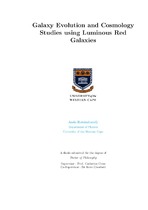| dc.description.abstract | There have been a number of attempts to measure the expansion rate of the Universe using age-dating of Luminous Red Galaxies (LRGs). Assuming that stars in LRGs form at the same time, age-dating of two populations of LRGs at different redshifts can provide an estimate of the time different associated with the corresponding redshift interval (dz/dt). This gives a direct estimate of the Hubble parameter H (z) at the average redshift of the two populations. In this thesis, we explore the validity of this method by using two different sets of data. Firstly, we select a homogeneous sample of passively evolving galaxies over 0.10 < z < 0.40 from the Sloan Digital Sky Survey Data Release Seven (SDSS-DR7) catalogue by applying a refined criteria, which is based on absolute magnitude. Secondly, we carry out series of observations on the Southern African Large Telescope (SALT) to obtain spectra of LRGs at two narrow redshift ranges z ' 0.40 and z ' 0.55 in order to calculate the Hubble parameter H(z) at z ' 0.47. We utilise two distinct methods of age-dating including the use of absorption Lick index lines and full spectral fitting on high signal-to-noise galaxy spectra from our sample. By establishing the age-redshift relation of the quiescent, passively evolving galaxies from SDSS, we obtain three improved new observational H(z) data points which are H(z) = 76.8 5.3 km s1Mpc1 at z ' 0.28, H(z) = 78.5 6.8 km s1Mpc1 at z ' 0.30 and H(z) = 86.3 7.6 km s1Mpc1 at z ' 0.32 respectively. We also find another H(z) value of 105 39 km s1Mpc1 at z ' 0.47 when age-dating LRGs observed with SALT. Combining all 4 data points with another 25 data points in the literature, we place better constraints on cosmological models and find the matter density parameter to be constrained by m = 0:32+0:05 0:06 and the Hubble constant to be H0 =68.5 2.4. These results are very consistent with other studies. Through this work, we are able to demonstrate that the cosmic chronometers approach can potentially be used to explore the evolution of the Universe. | en_US |

